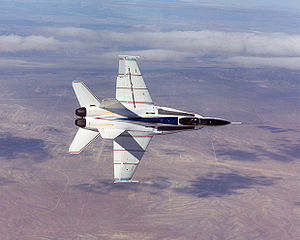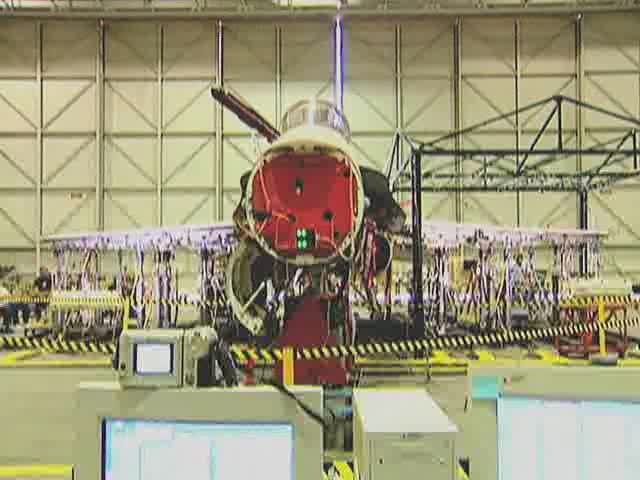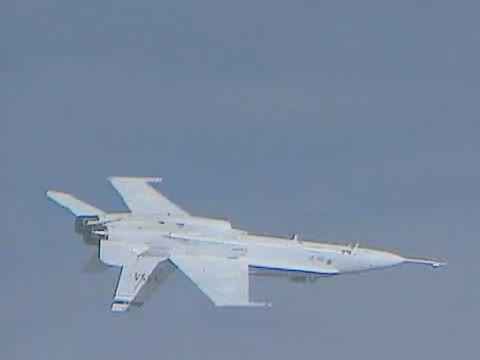Boeing X-53 Active Aeroelastic Wing Video - Picture

|
|
Boeing X-53 Active Aeroelastic Wing
X-53

Picture - F/A-18 configured by NASA as the X-53
Role: Technology Demonstrator
National origin: United States
Manufacturer: McDonnell Douglas
Northrop
Primary user: NASA
Developed from: F/A-18 Hornet
The X-53 Active Aeroelastic Wing (AAW) development program is a completed research project that was undertaken jointly by the Air Force Research Laboratory (AFRL), Boeing Phantom Works and NASA's Dryden Flight Research Center, where the technology was flight tested on a modified F/A-18 Hornet. The program was led by a cadre of people from these organizations, including Edmund W. Pendleton and Dr. Ken Griffin from the Air Force. Denis Bessette and Dave Voracek from NASA Dryden. Pete Field, Dr. Jim Guffey, and Eric Reichenbach from Boeing St Louis. Gerry Miller of North American Aviation (later part of Boeing). Jan Tulinius led the development of the initial concept during wind tunnel testing in the mid 1980s under Air Force contract. The designation "X-52" was skipped in sequence to avoid confusion with the B-52 bomber.
Design and development
Active Aeroelastic Wing (AAW) Technology is multidisciplinary in that it integrates air vehicle aerodynamics, active controls, and structural aeroelastic behavior to maximize air vehicle performance. The concept uses wing aeroelastic flexibility for a net benefit and enables the use of high aspect ratio, thin, swept wings that are aeroelastically deformed into shapes for optimum performance. This makes it possible to achieve the multi-point aerodynamic performance required of future fighter, bomber, and transport aircraft.
AAW Technology employs wing aeroelastic flexibility for a net benefit through use of multiple leading and trailing edge control surfaces activated by a digital flight control system. At higher dynamic pressures, AAW control surfaces are used as "tabs" which are deflected into the air stream in a manner that produces favorable wing twist instead of the reduced control generally associated with âaileron reversalâ caused by trailing edge surfaces. The energy of the air stream is employed to twist the wing with very little control surface motion. The wing itself creates the control forces.
As AAW attempts to promote and use favorable wing twist response at high speeds, it is viewed as a return to an idea first pioneered by the Wright Brothers. Active aeroelastic wing technology is a design approach that enables a higher aspect ratio, more aerodynamically efficient wing. Further, an active aeroelastic wing can be used to reduce induced drag at low wing strain conditions and, at higher strain conditions, reduce maneuver air loads. Overall benefits of AAW technology to future systems include substantially increased control power, reduced aerodynamic drag, reduced aircraft structural weight, and increased design latitude in terms of wing span, sweep, and thickness. Depending on mission requirements, these benefits should mean significant reductions in air vehicle takeoff gross weight and production costs

Picture - Time lapsed film of Active Aeroelastic Wing (AAW) Wing loads test
Aeroelasticity and controls
An aircraft maneuvers by deploying flight control surfaces into the airflow, which modify the lift of the surface they are attached to. For instance, the ailerons on the wings used to roll an aircraft work by increasing or decreasing the lift of the outer portion of one wing, while doing the opposite on the other wing. This imbalance in lift forces causes the aircraft to rotate around its length axis. The effects of ailerons on lift are complex; some of their effect can be attributed to the change in overall curvature of the wing as a result of their movement, while some of it is due to Newtonian deflection of the airflow.
It is the latter effect that is considered to be detrimental. When the aileron is deployed, the airflow is deflected at a point well behind the center of lift. This creates a torque around the span axis of the wing, which "flattens" it in relation to the airflow and reduces the effectiveness of the aileron input. Although this effect is quite small at low speeds, at higher speeds the amount of airflow over the surface can be considerable, enough to cause the entire wing to flex, an effect known as aeroelasticity.
Since the control force of the aileron is a function of speed, and an aircraft has to be maneuverable at landing and takeoff speeds, there is a lower limit to the size of the control surfaces that can be used. In some cases, like the Supermarine Spitfire and Mitsubishi Zero, this meant that at faster speeds the forces on the controls were extremely high. In the case of the Spitfire, these forces acted on a very thin wing that was highly elastic, and in dives the wing would twist so much that the lift curve was opposed to the motion of the aileron, reversing the direction of the roll. This problem required several rounds of upgrades to correct.
Active controls

Picture - F/A-18A (now X-53) Active Aeroelastic Wing (AAW) flight test, March 2005
The same problems affect modern aircraft as well, but are engineered to be less noticeable. To start with, improvements in materials and design has greatly improved the stiffness of the wing, reducing the magnitude of the problem. Once the plane is built and flown, the flight control software is then adjusted to correct for the loss of control due to aeroelasticity. However, this simply hides the problem; the aeroelasticity still exists and is affecting the overall control authority. To correct this the flight controller uses more control input to offset any loss of effectiveness, which increases the torque loads on the aircraft.
AAW developed from the simple observation that the aeroelasticity can be offset by the deployment of other control surfaces on the wing. In particular, almost all modern aircraft use some form of slat along the wing's leading edge to provide more lift during certain portions of flight. By deploying the slats at the same time as the ailerons, the torque can be equalled out on either side of the spars, eliminating the twisting, which improves the control authority of the ailerons. This means that less aileron input is needed to produce a given motion, which, in turn, will reduce aileron drag and its associated negative control aspects. Better yet, the wing is already designed to be extremely strong in the lift component, eliminating the torque requires lift, converting the undesired torque into an acceptable lift component.
But if one can use the controls to eliminate the twisting and its negative effects on control input, the next step is to deliberately introduce a twisting component to improve the control authority. When applied correctly, the wing will twist less and in an opposite direction to a conventional wing during maneuvering. So this change, which can be accomplished in software, has numerous benefits to overall performance.
AAW testing
To test the AAW theory, NASA and the USAF agreed to fund development of a single demonstrator, based on the F/A-18. Work started by taking an existing F/A-18 airframe modified with a preproduction pre roll mod wing, and added an outboard leading edge flap drive system and an updated flight control computer. Active aeroelastic wing control laws were developed to flex the wing and flight instrumentation was used to accurately measure the aeroelastic performance of the wing planform. Flight software was then modified for flight testing, and the aircraft first flew in modified form in November 2002. The aircraft successfully proved the viability of the concept in full scale during roll maneuver testing in 2004-2005. The test aircraft was re-designated X-53 on August 16, 2006, per memo by USAF Deputy Chief of Staff, Strategic Plans and Programs.
Specifications
Aeroelasticity
Parker Variable Wing
Adaptive Compliant Wing
Aeroelastic wing on the Grumman X-29
Related development
F/A-18 Hornet
Boeing X-53 Active Aeroelastic Wing Pictures
Living Warbirds: The best warbirds DVD series.
Source: WikiPedia